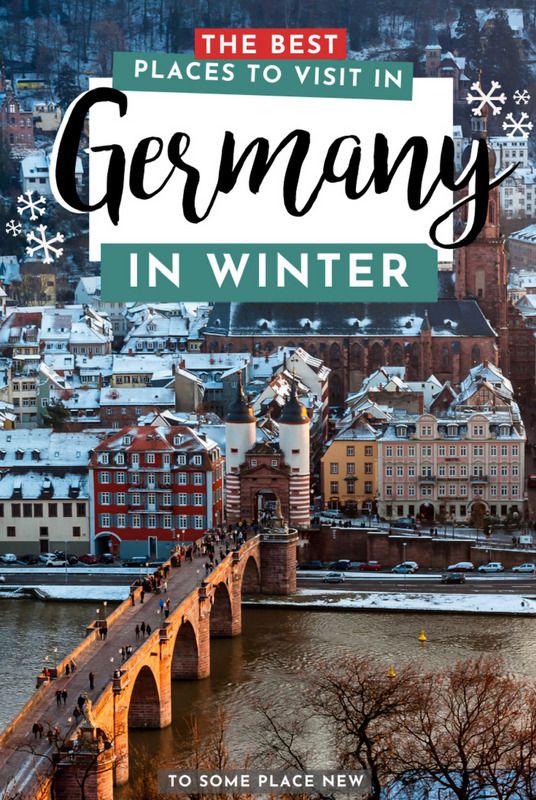Germany is a wonderland of mountains, castles, and ancient towns that, at any time of year, will amaze you. But a winter tour and the picture-perfect snow-covered landscapes are instantly only a little more magical, more alive. If you’re going to historic Berlin or the vast beauty of the Black Forest, in the colder months, Germany is full of destinations that are particularly breathtaking.
Apply cheaper rates and smaller crowds to that, and you’ll begin to understand why this is a country that’s best explored as temperatures drop. Do you need inspiration? Take a look at our list of winter’s best places to visit in Germany.
1. Zugspitze Mountain
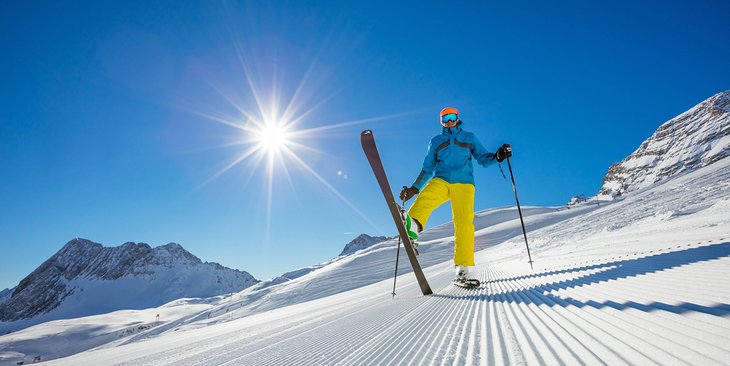
At the peak of the country’s tallest mountain is Germany’s finest ski resort. Located just under 3,000 meters above sea level, Zugspitze is home to three glaciers. Though it is best known for its cliffs, the mighty mountain also attracts climbers and mountaineers. For winter hiking and snowshoeing, the Zugspitze base provides plenty of trails.
Three cable cars and the Bavarian Zugspitze Railway (Europe’s third highest railway) make their way up the mountain, taking enthusiasts of sports to the winter sports region. Here, 20 kilometers of slopes will be available to skiers and snowboarders and ready for six months out of the year. Also, toboggan runs are available.
Many of the pistes are high above the clouds, and the 2,600-meter-high Zugspitz Plateau is famous for its sunny winters – a perfect combination to make thrill-seekers flock here as late as April.
For visitors who need a break from all the excitement, Zugspitze Mountain is home to several restaurants and huts, as well as the igloo village Zugspitze, which offers igloo rooms for a night to remember.
2. Cologne
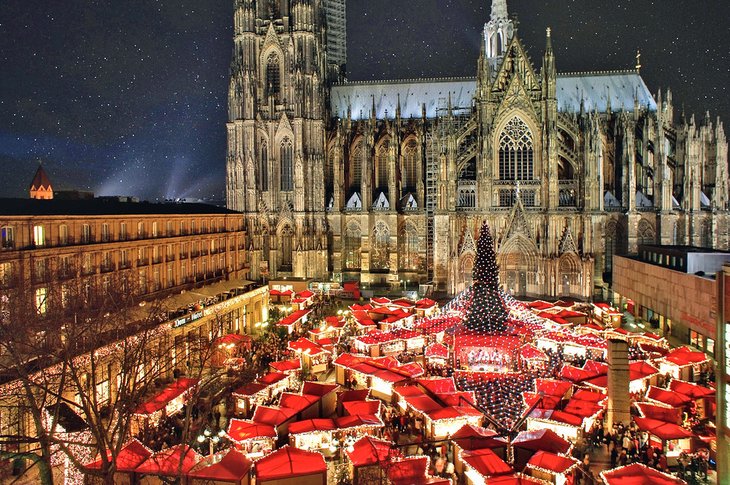
Cologne, the largest town in the region of North Rhine-Westphalia, has plenty to offer all year long. The city stays colder in winter than most of Germany, but it also sees some snow.
Head to the Claudius Therme thermal bath on those cold January days to try out their outdoor pools and saunas, warming up under the darkening sky. In February, Cologne’s carnival is also one of the largest in the world, with days of festivities and parades taking to the streets.
Some of the best Christmas markets in Europe are in Germany – and those in Cologne are particularly breathtaking. The largest Christmas market in the city is right in front of the 157-meter-high Gothic tower of Cologne Cathedral.
Here, over 150 wooden pavilions sell everything from hand-painted holiday cards to lebkuchen (gingerbread) cookies, traditional wooden toys, and quirky Tassen tableware.
Accommodation: Where to Stay in Cologne
3. Berlin
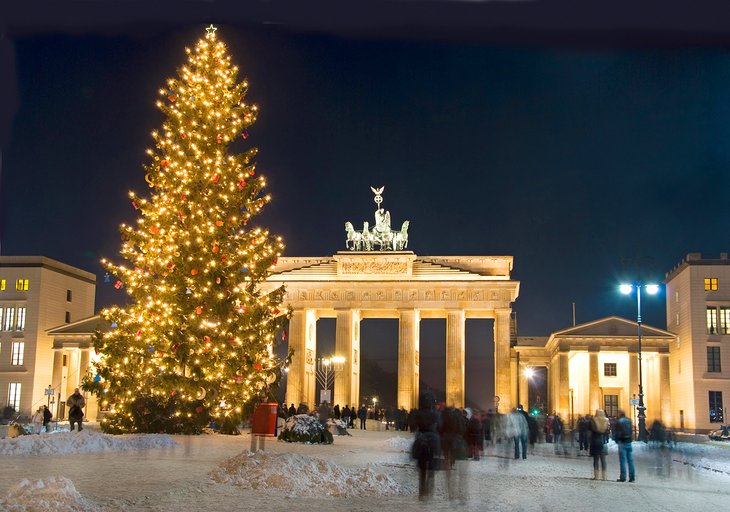
Berlin’s cold, snowy winters are great for indoor fun, but you can’t skip the Christmas markets if you’re visiting in December either.
The Winterworld of Potsdamer Platz, the historic Christmas market of Gendarmenmarkt and the Domäne Dahlem Advent market (located in a former manor) all give a different experience, mixing glassblowers, craftsmen, carousels and warm gingerbread for an unforgettable holiday experience.
Make time to visit the Botanical Garden, which is transformed into the Berlin Christmas Garden between mid-November and early January, packed with magical fairy lights and its own ice-skating rink, when you are bundled up for the cold.
The Berlin Wall’s outdoor exhibits are also a must at any time of the year.
For indoor entertainment, head to Berlin’s Museum Island, where five museums hold everything from sculptures and art to the Pergamon Altar and the Ishtar Gate of Babylon. Winter is the perfect time to visit the museums, as the crowds are much smaller.
Best Places To Visit In Germany
You can also tour the Reichstag (Germany’s parliament building), see a show at the world’s biggest theater stage (the Friedrichstadt Palast), and pick up some souvenirs at Europe’s largest department store, Kaufhaus des Westens.
Accommodation: Where to Stay in Berlin: Best Areas & Hotels
4. Baden-Baden
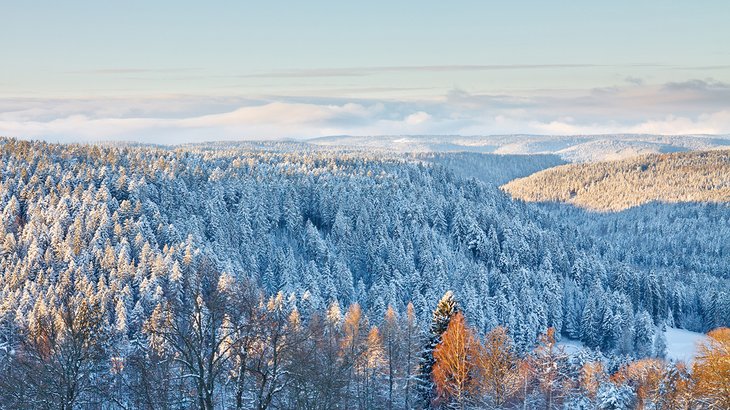
The charming spa town of Baden-Baden, facing the Black Forest, sits along the border with France. Although a great destination in any season, winter adds to the region’s charm. Snow turns the Black Forest into a winter fairy tale, supplying the many well-laid trails just minutes from Baden-Baden with opportunities for snowshoeing and cross-country skiing.
You can also take the historic Merkurbergbahn (cable car) up Merkur Mountain for breathtaking views and explore the many winter trails there. Or hike up to the castle ruins of Hohenbaden Castle, crowning the hills above the city.
Back in town, in December, there are plenty of Christmas markets to visit. You can take a walk through Lichtentaler Allee park, then grab a table for some typical chocolate truffles at one of the many cozy cafés around.
Or visit the late Gothic church of the Stiftskirche, then head to the Frieder Burda Museum to see an impressive collection of Modernist and Expressionist art.
Baden-Baden has plenty to sell as a resort town as well. Take a hot dip in the thermal waters of the Caracalla Spa in winter, try a Roman bath in Friedrichsbad, or walk into a salt cave for a salty sea-like breeze.
5. Mosel Valley
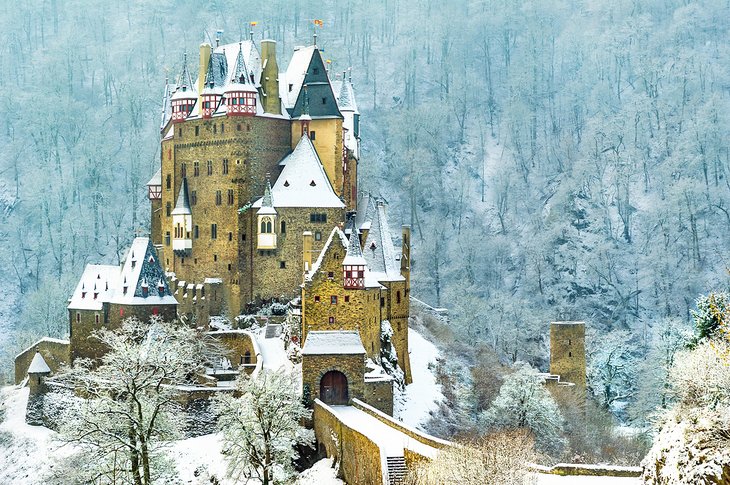
Located in southwestern Germany, The Mosel Valley is home to several quaint towns and storybook castles and spreads to France and Luxembourg. Especially spectacular in winter, the towns of Cochem and Burg Eltz offer magnificent views of the river, ancient castles, and plenty of hills for hiking – all more magical under a dusting of snow.
In winter, the castles and historical sites across the valley are great – the fog and snow add to the mystery, and the sites are almost deserted, free of the huge crowds that you would find in summer. The Christmas markets in the area, especially the historical ones at Zell a der Mosel and Bernkastel-Kues, illuminate the valley in December. Even in winter, it’s worth braving the cold to explore the Old Town centers in the area. Half-timbered buildings that seem out of a fairy tale line up the streets and make for great photo opportunities. While the river cruises don’t run in winter, you can take the train from Koblenz to Cochem and get similar scenic views along the way.
6. Hamburg
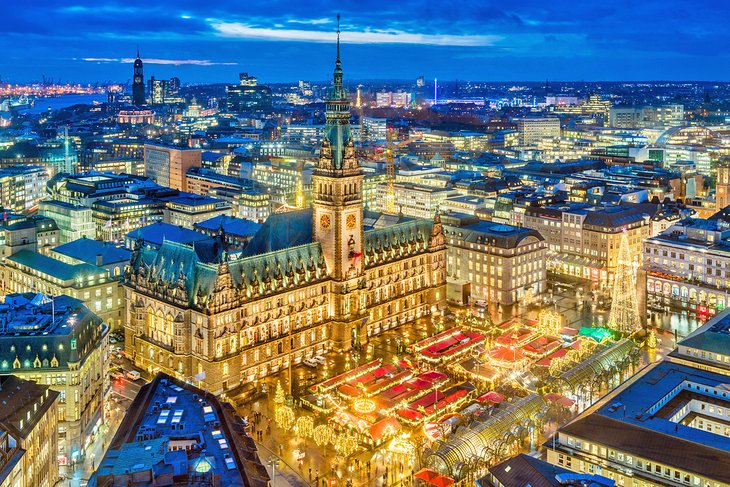
Most of Germany is turned into a snowy wonderland by winter, but the old city of Hamburg makes the most of the cold weather. Hamburg begins offering advent concerts in the city’s many churches as soon as the temperatures drop, and Christmas markets begin selling stollen (fruit cake), as well as hot chocolate for shoppers. An ice rink pops up in winter in the inner-city park of Planten un Blomen park, complete with colorful lights and weekend DJs.
Germany Travel Costs
Hamburg sits on the Elbe River and is home to several canals and over 2,500 bridges, ideal when the fog rolls in to photograph the city’s lights. For a more in-depth water experience, head to the pier at Landungsbrücken to catch a winter cruise.
Near the pier, you’ll also find two museum ships: the cargo ship Cap San Diego and the three-masted sailing ship Rickmer Rickmers. It’s possible to book passenger cabins to sleep on the Cap San Diego.
For a break from the cold, check out the Internationales Maritimes Museum Hamburg or visit the world’s largest model railway and miniature airport museum at Miniatur Wunderland, one of Hamburg’s top attractions. Hamburg is home to over 60 museums and 40 theaters, so finding things to do indoors won’t be hard.
Accommodation: Where to Stay in Hamburg
7. Garmisch-Partenkirchen
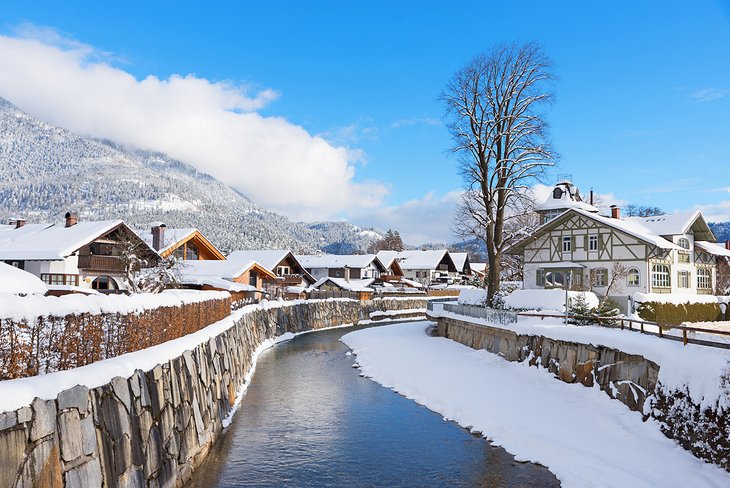
The two towns which make up Garmisch-Partenkirchen are a winter haven for nature lovers, about an hour and a half from Munich and at the foot of the mighty Zugspitze mountain.
The Olympic Games of 1936 took place here, and its proximity to some of the highest and most spectacular mountains in the world means that it is a prime destination for skiing, winter hiking, and cross-country skiing. The historical Olympiaschanze ski jumping hill is worth a short visit as well.
But Garmisch-Partenkirchen is more enjoyable than just snow. A leisurely stroll through the Partenkirchen neighborhood and its typical half-timbered scrollwork houses is a perfect way to spend a sunny winter afternoon –
– especially if you make some time to sit down at a local café for some chocolate cake.
For some indoor fun, stop by the Werdenfelser Heimatmuseum and get a peek of local life in the 1800s. And for a stunning view of the alpine surroundings, hop in one of the many gondolas that depart from town, including the Hausbergbahn Gondola, which goes 1,338 meters up Hausberghöhe mountain, or the Alpspitzbahn cable car, which takes you up the Zugspitze to the breathtaking AlpspiX viewing platform.
Accommodation: Where to Stay in Garmisch-Partenkirchen
8. Neuschwanstein Castle
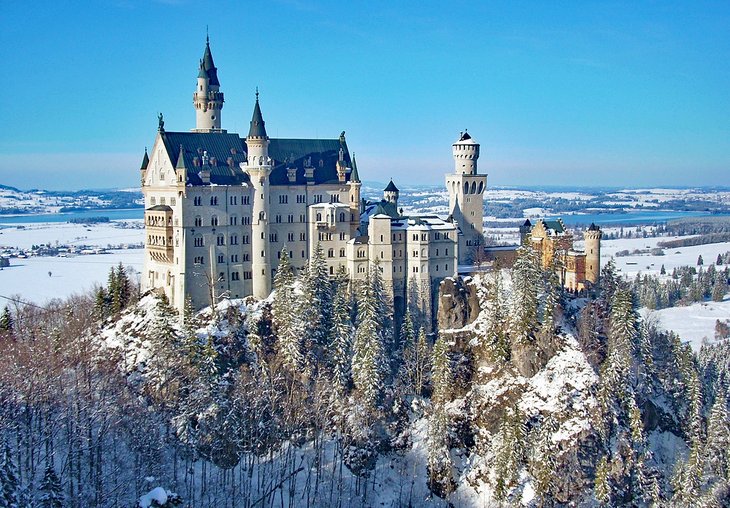
There are many impressive castles in Germany, but few can equal the charm of Castle Neuschwanstein, the castle that inspired Disney’s Princess Castle.
In the heart of Bavaria, the Romanesque Revival palace sits on a hill. Originally commissioned to be used as a refuge by King Ludwig II of Bavaria, after his death in 1886, the castle was almost immediately open to the public. Just 15 out of the initial 200 rooms planned were ever completely completed. Visitors will visit the quarters of the king and some of the other rooms today.
Top 5 Things To See And Do In Germany
The castle sees as many as 6,000 visitors a day during the warmer months, but in winter, things are much quieter.
Group tours are smaller, photos are better when fewer people are around, and the frosty endless forests around add to the magic.
In addition, the train ride from Munich to Neuschwanstein Castle is stunning in winter, as the train crosses alpine villages and forested mountains dusted in snow.
9. Partnach Gorge
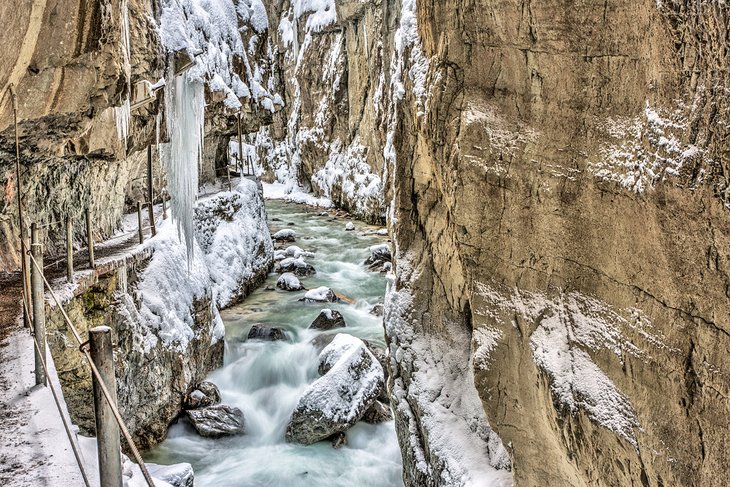
In summer, the majority of tourists going to the Partnach Gorge arrive – but the Partnach is equally amazing in winter, particularly after heavy snowfall. It sits between two huge limestone walls in the Reintal valley that exceed 80 meters high in some places. Visitors will walk along the river, behind the frozen waterfalls, and over the snow-covered rocks below the river, deep into the gorge.
With additional trails that take you over suspension bridges and through deep green woods, the gorge is 700 meters long. Only during winter, guided torchlight hikes are conducted through the gorge for those with an even greater sense of adventure. It is an experience of magic,
walking in the dark with the light reflecting on the surrounding trickles of ice.
The nearby winter resort town of Garmisch-Partenkirchen offers plenty to do, and the picturesque Alpine lakes Eibsee and Riessersee offer additional winter hikes and picture opportunities.
10. Dresden
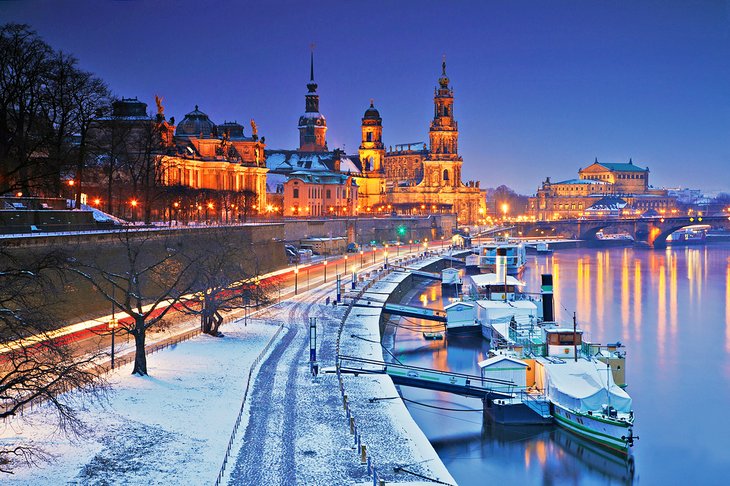
Host to the oldest officially recognized Christmas market in Germany, Dresden really puts on a display during the holiday season. Craftsmen are still present – selling Silesian ceramics from Saxony, wood carvings from Ore Mountain, and plenty of blown-glass ornaments – and Dresden is also well known for selling traditional Christmas Stollen.
During WWII, Dresden was badly damaged by bombings and rebuilt painstakingly over the next few decades. Visitors today will see the Baroque palaces and churches again in all their glory. One of the best places to visit in the winter, when advent concerts take over the area, is the Hofkirche church, restored using some of the original saved stones.
And the magnificent Zwinger Palace is equally stunning under a dusting of snow.
The inner courtyard of the Palais Taschenberg gets transformed into a giant ice-skating rink between November and January every year. Indoors, the shopping malls get decked for the cold weather with great sales and local food specialties.
And if you’re inclined to take a little day trip, the winter resort town of Altenberg is less than an hour away. Here, you’ll find 14 cross-country ski trails, plus plenty of opportunities for winter hiking, snowshoeing, and tobogganing.
Accommodation: Where to Stay in Dresden

